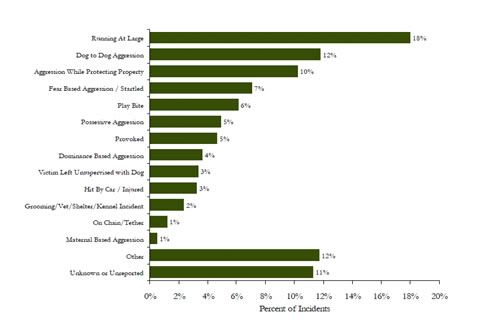 It is Dog Bite Prevention Week and I wanted to alert you to an interesting report that was done in Colorado.
It is Dog Bite Prevention Week and I wanted to alert you to an interesting report that was done in Colorado.
Dog Bites in Colorado is a 55 page report that is very specific to the state of Colorado but it shares some interesting facts and can be found at Living Safely With Dogs (along with some great tips).
Contrary to what many people think most dogs do not bite–and the year long Colorado study found that less than 1/3 of 1% of dogs actually bit a human.
However, in the Colorado study 62% of bites inflicted injuries involved one or more puncture bites.
Dogs running at large was the single most common bite circumstance.
Here is something else everyone should take note of–approximately 50% of all dog bites occurred at home when a dog was protecting property, food, or toys.
 Above: Dog Bites in Colorado Chart of Where Dog Bites Occur
Above: Dog Bites in Colorado Chart of Where Dog Bites Occur
The findings, as you would expect, state that the way to prevent dog bites is through education of dog owners and the general public because most incidences occur because of the inappropriate behavior from people and dogs.
Colorado Dog Bite Study Statistics
- Male dogs bit twice as often as female dogs and caused more serious injuries.
- Male dogs were responsible for 60 percent of bites.
- Male dogs were more likely to bite while protecting property, food, or toys
- Female dogs were more likely to bite during dog-to-dog aggression.
- Adolescent dogs (between one and four years of age) were responsible for the most bites.
Many people are writing about Dog Bite Prevention Week so I thought I would boil dog bite prevention tips down into some bullet points under specific topics. Once you read these I encourage you to research or explore further.
Living safely with dogs requires
- socialization to dogs and humans,
- obedience training,
- supervision of family dogs,
- owner education about how to manage pets and about local dog laws.
How do you avoid dog bites?
- Avoid approaching any strange dog.
- Do not pet a dog without asking permission.
- Study the body language of dogs and be able to identify typical dog behavior and potential problems.
- Learn just what constitutes appropriate human-dog interactions.
- Error on the side of safety by being conservative around all animals.
Dog bite liabilities include
- medical attention for family members,
- medical bills for non-family members,
- law enforcement fines,
- quarantine fees,
- and higher insurance premiums.
Additional steps to avoid dog bites are to
- supervise and safely confine or house your dog,
- always obey leash laws in public places,
- be alert to your surroundings especially in public areas where dog encounters are likely to occur,
- be prepared for children who may approach your pet unexpectedly.
It also helps to carry some sort of pepper spray or related product if you are worried about a dog attack. Hikers in my area find them valuable in deflecting dogs attacks on their dogs or on their hiking parties.
Other actions you can take locally are to
- report aggressive dogs,
- remain wary of tethered or chained dogs,
- avoid loose dogs in public areas,
- and report any dog bites.
How much risk do children face from dog bites and how do you keep them safe?
Children (14 and under) are at the highest risk of being bitten and the most common victims in the Colorado study were boys between 9 and 10 years old.
- Always supervise children and animals when they are interacting.
- Do not leave any child unattended with a dog (or any animal).
- Teach children about how to be safe around dogs.
- Coach children to treat dogs with care, consideration, and respect.
 Above: Situations Where Dog Bite Incidents Occur from Colorado Study
Above: Situations Where Dog Bite Incidents Occur from Colorado Study
Do you have any favorite tips about how to prevent dog bites? What is your community doing to educate the public during dog bite prevention week? Leave your comments below.

